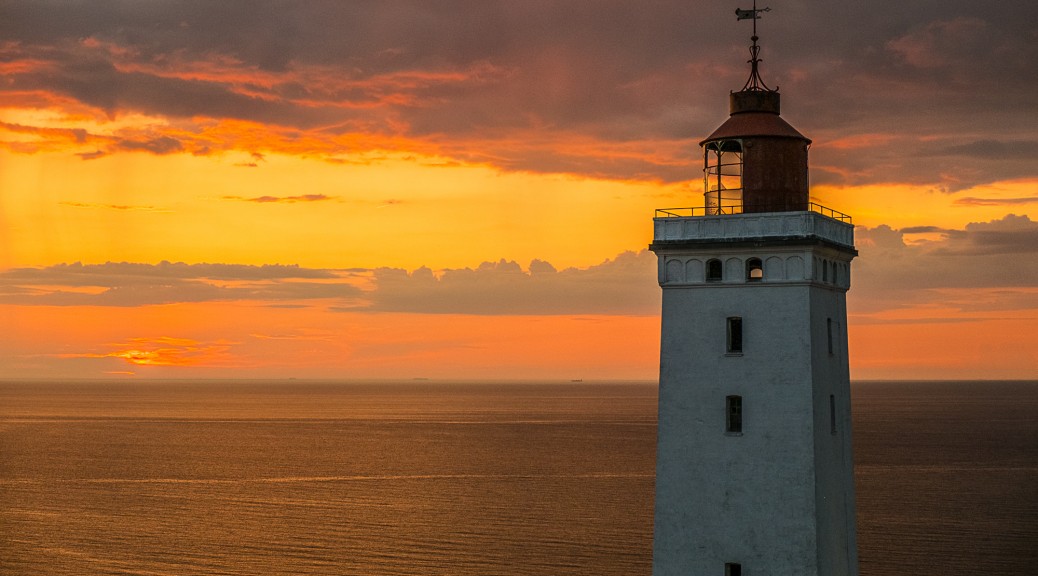The North Sea Cycle Route follows a 6000 km long path from the city of Bergen in Norway all the way along the coast around the North Sea to the village Norwick on the Shetland Islands.
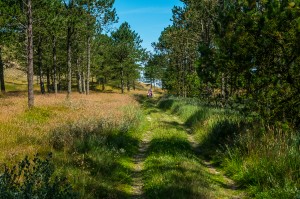
500-some km of the great North Sea Cycle Route’s 6000 km go along the North Sea Coast of Jutland. In Denmark known as the Westcoast, hence the routes Danish name, Vestkystruten (Westcoast Route). The danish westcoast is famed for its strong winds, great waves and wide, sandy beaches, in the north and the Wadden Sea in the south.

The Westcoast is where many danes (and germans) traditionally spend their summer holidays from late June to July, when the temperatures reach the 20’ies, to catch a refreshing dip in the waves (the water temperature, though, rarely even comes near the 20’ies). The small towns, inns, hostels and campsites are relatively busy in the 6 weeks of high season – in stark contrast to the rest of year (see Jesper’s experiences while Cycling home for Christmas).

On this particular trip we, a family of four with the youngest being 8 years old, went the upper half of the danish part of the route, from Agger to the top of Denmark in Skagen in 10 sunny cycling days and two rainy restdays. Around 330 km all in all (including multiple trips to the beach and unintentional detours).
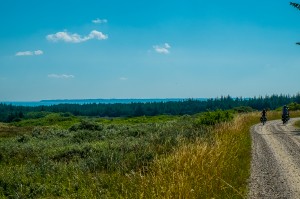
Acctually, we went from the nearest train station was Hurup Thy, from where it is some 11 km to the camping at Agger, added a detour to see the passage-grave at Lundehøj, 5 km in the opposite direction, making the first day a 20 km stretch. The train takes an epic 5 hours from Copenhagen, including changes at Vejle* and Struer.
Highlights
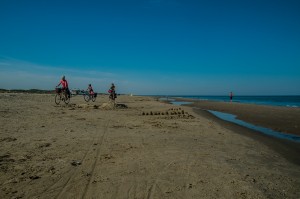
It is advisable to seek down to the shoreline where the sand is more compact, while the public road (also on the beach) often is difficult to ride on due to the sand.
Among the highlights of this tour are riding on the white sand beach, surfing the waves of Cold Hawaii, the frenetic summer life of the coastal towns, the famous chefs and restaurants’ summer residencies in Skagen and the beach hot spots. The Thy National Park, the rough nature, the numerous signs of the locals fight against the sand: where they lost and the churches houses and even beacons were buried. Also the enormous wandering dune, that slowly wanders across the land crushing everything in its path, the remains of the German WWII Atlantic fortifications – bunkers in various states of disrepair dotting the coast line all the way to Skagen. The
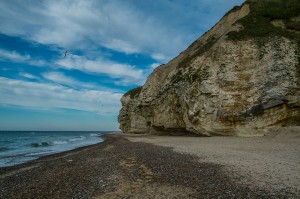
Skagen Museum dedicated the famous Skagen Painters, Michael and Anna Ancher and P.S. Krøyer (anyway, the museums restaurant in the museum garden is nice and serves delicious food).
For the youngest there are 500 km of sand beach, amusement parks, many nature playgrounds and lots of places to get ice cream, along the route.
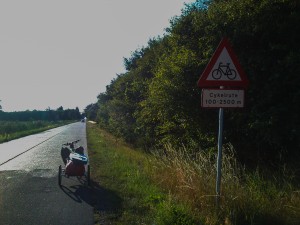
The open and wide landscape makes it possible to stay out of eventual downpour by stepping back some meters
Somewhat off the route in Thy you may find Kirsten Kjærs Museum, museum for a (rather unknown) female artist and collector who was in the midst of the cultural elite of the 20th century, Thylejren, the first danish hippie commune, still waving the hippie flag high – famous for having had John Lennon and Yoko Ono staying there. Although not really a tourist sight (like Christiania is), they have cheap beer and soft drinks for a refreshment.
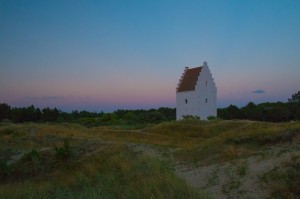
If you’re not content with just going along one route, og might want to see something off-route, you can follow the sign-posted detours, called Panorama-routes, roundtrips of 20 to 50 km along the traditional cycle route. On the northern part of the Westcoast Route so far 7 Panorama-routes have been made.
Nice to know
Apart from the occasional grand gourmet apperances by danish chefs relocating for the summer to traditional foodie “hotter spots” like Skagen and Lønstrup, food on the Westcoast is rather basic, and most surprising, rarely fresh fish. Pizzas, burgers and kebabs rule the tables. In the tourist centres in the season you may find restaurants or cafees with an alternative offering. It pays to have your eyes open.
Technincal data
The route is almost flat, though it has some climbs that that can challenge the rider of a heavily packed bike, mainly due to the tracks rough surface.
The quality of the surface varies a lot along the route. From the high grade tarmac in Thy National Park, to gravel, dirt, concrete plates, grass and even sand – of course along the shore line but also on some paths further inland.
As many cyclists say: “The mountains in Denmark are flat”, and refer to the at times strong and continious winds, that really can take the energy from you.
You can go on a normal touring or everyday bike as we did, or, if you would like to try out some of the great mountain bike tracks, fit a mountain bike with panniers.
Notes
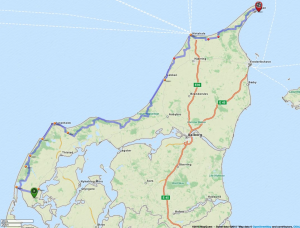
* Usually the ticket states that you change at Fredericia, but that means that you will have to change platforms (with bikes and stuff) in a rather short time. Changing at Vejle is less stressfull since there is only one platform, and the trains go on the same tracks, so they will come in the right order. Ask for advice from the personel on the train.
Additional links
The Route: http://cyclistic.dk/da/?routeID=96b3fc95-c02b-4d45-b5fe-5c9e70bf1ece
North Sea Cycle Route: http://www.northsea-cycle.com/
West Coast Route: http://vestkystruten.dk/
